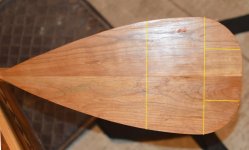Like I said in an earlier post, the easiest way I have found to determine the area for an odd shape ... such as paddles, is to just take a piece of paper that is big enough to draw the shape on.
1. Measure the length/width to get the area of that piece, and then fold the paper up and weigh it
2. Draw the blade shape and cut it out
3 fold the cut out and weight it
So as an example, you have a rectangular paper piece that is 10" x 36" and it weighs 2 oz
The area is 360 square inches and the weigh/squareInch is 2 /360 or .00555 oz/squareInch
Your cutout blade shape weighs .56 oz .. the area is .56/.000555 = 100.9 squareInches
This is all predicated on the fact that paper usually has a very uniform thickness and composition. If you have a stack of the same paper, you just measure once to get that weight per square inch, then you can easily determine the area of any shape pretty fast and easy.
Brian
It seemed like more bother than it is the first time I read it.


